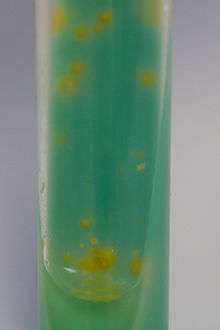Mycobacterium kansasii
| Mycobacterium kansasii | |
|---|---|
 | |
| Scientific classification | |
| Kingdom: | Bacteria |
| Phylum: | Actinobacteria |
| Order: | Actinomycetales |
| Suborder: | Corynebacterineae |
| Family: | Mycobacteriaceae |
| Genus: | Mycobacterium |
| Species: | M. kansasii |
| Binomial name | |
| Mycobacterium kansasii Hauduroy 1955,[1] ATCC 12478 | |
Mycobacterium kansasii is a bacterium in the Mycobacterium family. The genus includes species known to cause serious diseases in mammals, including tuberculosis and leprosy,[2] but this species is generally not dangerous to healthy people.
Description
Gram-positive, nonmotile, moderately-long to long, and acid-fast rods.
Colony characteristics
It forms smooth to rough colonies after 7 or more days of incubation and is considered a slow grower. Colonies grown in dark are nonpigmented, when grown in light or when young colonies are exposed briefly to light, colonies become brilliant yellow (photochromogenic) according to the Runyon classification of Non-Tuberculous Mycobacteria. If grown in a lighted incubator, most strains form dark red crystals of β-carotene on the surface and inside of colony.
Physiology
Its physiology is described as growth on Middlebrook 7H10 agar at 37°C within 7 days or more, resistant to pyrazinamide and susceptible to ethambutol.
Differential characteristics
It is closely related to the non-pathogenic, also slowly growing, nonpigmented, M. gastri. Both species share an identical 16S rDNA but differentiation is possible by differences in the ITS and hsp65 sequences. A commercial hybridisation assay (AccuProbe) to identify M. kansasii exists.
Pathogenesis
Chronic human pulmonary disease resembling tuberculosis (involvement of the upper lobe).[3] Extrapulmonary infections, (cervical lymphadenitis in children, cutaneous and soft tissues infections and musculoskeletal system involvement), are uncommon. Rarely causes disseminated disease except in patients with severely impaired cellular immunity (patients with organ transplants or AIDS). Patients with silicosis are at risk. Also appears in patients with hairy cell leukemia, but not in other lymphoproliferative disorders.[4] Mycobacterium kansasii occasionally involves the skin in a sporotrichoid pattern.[5]:341 Normally considered not to be contagious from person to person. Natural sources of infections unclear. Tap water is believed to be the major reservoir associated with human disease. Biosafety level 2 is indicated.
Type strain
First and most frequently isolated from human pulmonary secretions and lesions.
Strain ATCC 12478 = CIP 104589 = DSM 44162 = JCM 6379 = NCTC 13024.
References
- ↑ Hauduroy, P. (1955). Derniers aspects du monde des mycobactéries. Paris: Masson et Cie. OCLC 876707134.
- ↑ Ryan KJ; Ray CG, eds. (2004). Sherris Medical Microbiology (4th ed.). McGraw Hill. ISBN 0-8385-8529-9.
- ↑ Mycobacterium Kansasii at eMedicine
- ↑ Wintrobe, Maxwell Myer (2004). Wintrobe's clinical hematology. John G. Greer; John Foerster, John N. Lukens, George M Rodgers, Frixos Paraskevas (11 ed.). Hagerstown, MD: Lippincott Williams & Wilkins. p. 2467. ISBN 0-7817-3650-1.
- ↑ James, William D.; Berger, Timothy G.; et al. (2006). Andrews' Diseases of the Skin: clinical Dermatology. Saunders Elsevier. ISBN 0-7216-2921-0.
External links
- "Mycobacterium kansasii". NCBI Taxonomy Browser. 1768.
- Type strain of Mycobacterium kansasii at BacDive - the Bacterial Diversity Metadatabase